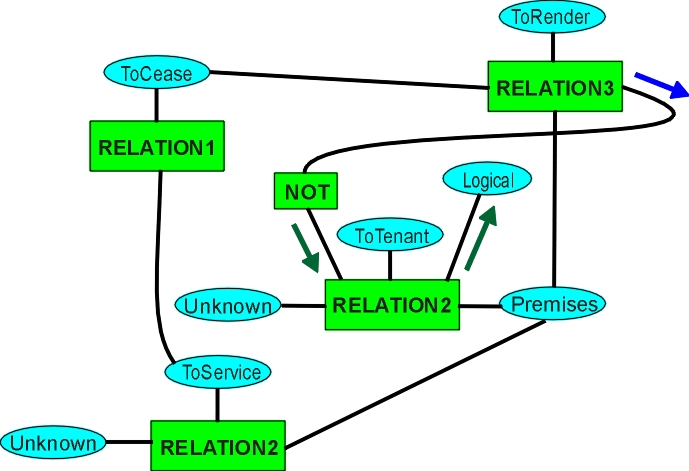
Each of these words can set up a long range relationship.
The said materials...
Any such determination....
If Tenant so contends.....
The same rate...
"Said", "such" and "so" usually set up relationships with previously described objects – searching backwards, either in the same sentence or in structure generated by previous sentences or subclauses, will encounter the object (it is assumed that these words can match all the way back to the beginning of a clause or section of a contract, but do not match across clause or section boundaries). The object need not be identical, but must be consistent, with the immediate object of the word usually being more general than the object to be searched for.
"Such" can also be used as a forward reference, as
Landlord's right to lease such space to any current or future tenants of the Office Complex who have renewal rights in their respective leases, such portions of the rentable area of the 31st, 32nd and 33rd Floors of the Office Complex........as are contiguous and become available.......
The sentence is the first in the clause, and there is nothing before "such space" that would match. Moving forward, it matches with "such portions", which itself is a forward reference to the definition (portions which are contiguous and become available).
Some uses of "same" refer to previous definitions, as
Tenant A pays $5 per square foot. Tenant B pays the same.
or
Tenant A pays $5 per square foot. Tenant B pays the same rate.
Another use of "same" is to assert continuity.
The premises have had the same tenant for five years.
"Same" can also set up a forward-looking relation, which makes it more difficult to handle. The immediate connections, such as
It is the same as this
This is the same rate as the rate Tenant pays.
are easily handled. Of more difficulty is the long range version
The same rate of net base rent per square foot of rentable area as for the premises.
Once this has been turned into higher level objects, the "same" can’t be seen, as
NounPhrase Preposition NounPhrase Preposition NounPhrase as Preposition NounPhrase
Instead of having a whole new class of noun phrases that are a mixture of properties – SameSubjectNounPhrase etc. the connection to "same" will cause a link to another parent for the noun phrase, so it will appear in place as
SubjectNounPhrase
but it will also be a child of "SameNounPhrase", so patterns anchored on the "as" can recognise it and link the objects. But how do we expose the "SameNounPhrase" through a prepositional, as
It is made of the same type of material as used in satellites.
The "same type" and SameNounPhrase have been swallowed, as
Pronoun ActiveVerbPhrase PrepositionalPhrase PrepositionalPhrase as Participial
We either need to continuously expose the SameNounPhrase property as the object moves to higher levels, or have a type of connection capable of boring into a grammatical structure to determine if it has a particular property (WITHPROPERTY does this).
If we allow the property to rise, then we need a limit on how high it rises – the property of a noun phrase in a prepositional chain should not be visible outside the chain, for instance.
Point of Connection
.................as a result of such cessation, the Premises or a material portion thereof, is rendered untenantable and Tenant in fact ceases to use the Premises, or material portion thereof, .....................In the event the entire Premises has not been rendered untenantable by the cessation in service, the abatement that Tenant is entitled to receive shall be pro rataed based upon the percentage of the Premises so rendered untenantable
We can find the original point, but also need to determine how to connect the new reference. In this example, it could be rewritten as
In the event the entire Premises has not been rendered untenantable by the cessation in service, the abatement that Tenant is entitled to receive shall be prorataed based upon the percentage of the Premises so rendered untenantable
by the cessation in service.
Cessation of service to the Premises caused the Premises to be untenantable to anybody, not just the Tenant. The True coming out of ToRender (a causative verb) is negated, then connected to the existence of the ToTenant relation – what untenantable means.
If the Office Complex is less than ninety percent (90%) occupied during all or portion of any year, then Landlord shall make an appropriate adjustment of the Tenant Expenses for such year, employing generally accepted accounting
principles to determine the amount of Tenant Expenses that would have been paid or incurred by Landlord had such Office Complex been ninety percent (90%) occupied, and the amount so determined shall be deemed to have been the amount of Tenant Expenses for such year.This is a much simpler case, where an amount is identified with a previous one.
The reference "...such Office Complex..." is redundant, as there is only one Office Complex.
The references
"...any year.......such year..............such year."
are straightforward, and "...that year" could have been used.